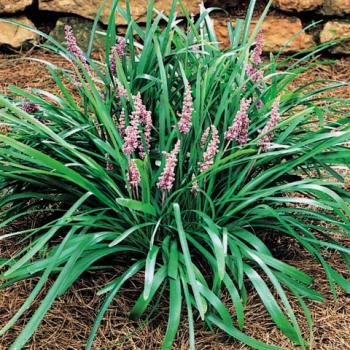
Li-rye-ope or lir-ee-ope?
Ground covers continue to be popular landscape plants in the southeastern United States. The most popular ground cover for landscape use in the south is liriope. Liriope goes by the scientific name of Liriope. The three main Liriope species grown in the southeastern United States are L. muscari (clumping), L. gigantean (giant) and L. spicata (spreading).
One question that frequently is raised is “How do you pronounce liriope?” Well, horticulturists who sell liriope say “li-ri-o-pe” is an expensive plant and “lir-i-ope” is a cheap plant!
Liriope should not be confused with monkey grass, also known as Mondo grass. These are separate plants belonging to different plant genera. Sometimes you hear these plants collectively called “border grasses,” but you can never be sure to which ground cover this is referring.
Although liriope is a great plant, occasional problems arise with landscape use. Growers, landscapers and home gardeners have long wanted improvements over existing varieties in terms of growth habit, uniformity in sun and shade performance, and winter aesthetics. Many liriope “lay flat” in the landscape during the winter. This is not desirable.
About 20 varieties of various liriope species are in the commercial trade. Big Blue, or some form thereof, is the main variety you find at garden centers, although it will just frequently just be named green liriope. You also buy variegated liriope. Green liriope is usually best suited for sun while variegated liriope is usually best suited for shade. But some green liriope do better in full sun than other varieties, and several varieties with green foliage need more shade than sun.
Disease resistance is being sought in liriope. Anthracnose, caused by the fungus Colletotrichum, causes spotting and browning of leaf blades. This is commonly observed in winter and is also a problem in late summer and fall after periods of heavy rainfall or during over-irrigation. Pythophthora root rot, or crown rot, of liriope, which leads to root death and a yellowing of leaf blades in the crown of the plant canopy, has also become an ever-growing problem in the past five years. Anthracnose can be controlled with fungicide applications, but the root/crown rot is very hard to control once the disease is established.
Many new liriope, and also Ophiopogon varieties, have been released from wholesale nurseries over the past five-10 years. Most of these have not been trialed under landscape growing conditions in the southeastern United States.
The new liriope varieties to try that are improvements over the industry standards are Marc Anthony, Emerald Goddess and Super Blue.
Marc Anthony is a new release from Plant Development Services, Inc. (PDSI), Loxley, Ala. – these are the same folks that are bringing us Southern Living Plants. It is an “improved,” variegated-foliage variety with new foliage originating as golden yellow and green. Foliage becomes white and green when maturing. Lavender blooms peak in midsummer. It is reported to reach 16 inches tall, is recommended for USDA hardiness zones 5-9 and is recommended for full sun to partial shade.
Emerald Goddess is from Rode Groundcovers in Florida and is a liriope with lavender flowers. It is taller-growing than most Liriope muscari varieties, maturing at a height of 18 inches in Louisiana plantings. It is fast growing. It has superior resistance to common fungal diseases. Dark green foliage is retained in winter with upright blades. Floral display is improved also. It is recommended for a large geographical area – USDA hardiness zones 5-10.
Super Blue is a new phenotypic selection from Big Blue. Has much more vigorous growth than other Big Blue selections. It is a taller-growing Liriope muscari and keeps excellent, bright green, upright foliage in winter. It is a slightly taller form than Emerald Goddess This variety was developed by KPS Sales, Apopka, Fla., and is recommended for USDA hardiness zones 5-9. Emerald Goddess and Super Blue have good resistance to disease, making them excellent landscape plant suggestions.
How do you get the best out of liriope in your landscape?
•Select the best-performing varieties.
•Match your sun/shade situation with the variety being planted.
•Make sure landscape beds are raised and well-drained.
•Limit irrigation.
•Prune liriope in late winter prior to new leaf blade emergence.
•Fertilize annually in spring with a slow-release landscape fertilize.
•Thin plantings, especially in border situations, once every three years to maintain vigor.
For more information, contact Dr. Chris Robichaux, county agent/area horticulturist, St. Martin/Iberia parishes, at 332-2181 or 369-4440.
- Log in to post comments
